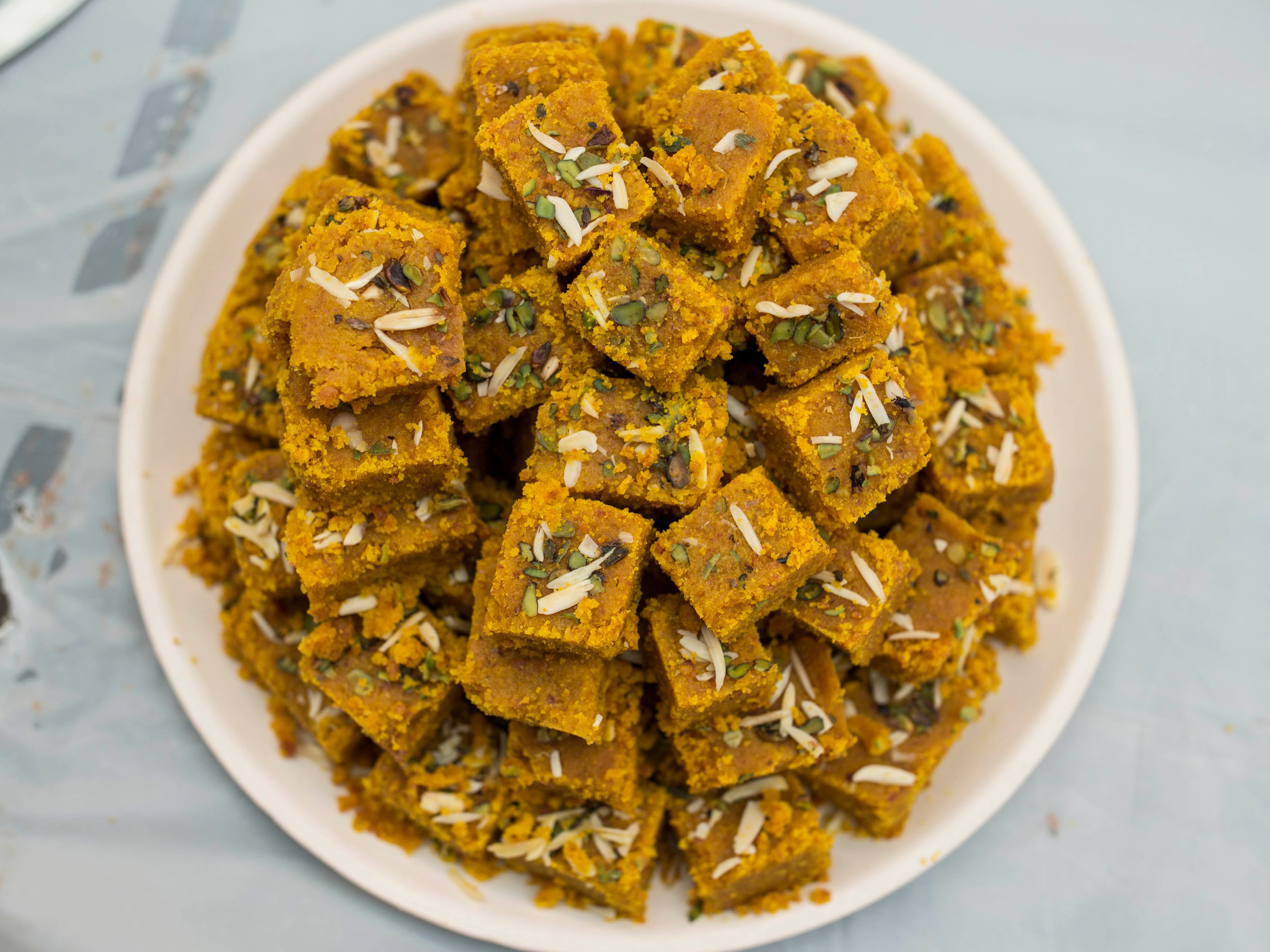How to make besan ki barfi at home for Diwali and Durga Puja
Romy Gill writes about her love of two of autumn’s biggest Hindu festivals – and the traditional sweets to celebrate them with


Throughout both my childhood and my adult years, Diwali has held a very special place in my life. As a child, the regular Hindu festivals throughout the year were hugely important to us: without the phones and other gadgets we’re used to now, they were a form of entertainment as well as times of religious significance.
As a Punjabi born in West Bengal, I grew up in a family where the emphasis was on education and respecting others – and living in an India that was not divided, we celebrated the festivals of all different religions.
Just prior to Diwali, though, Durga Puja – the 10-day celebration of the goddess Durga – was a huge celebration for many of my friends. Five days of the festival are packed with rituals, beginning with Mahalaya, when Hindus offer food and water to their ancestors who have passed.
On the sixth day (Sashthi), Hindus welcome the goddess Durga and begin the celebrations, while days seven to nine mark the main worship days of the festival.
On day 10 (Vijaya Dashami) – the day when Durga came out victorious in a battle against Mahishasura – clay idols are carried to the local rivers in processions, where they are immersed in a ritual that is about returning the goddess to the cosmos.
There are also drumbeats, chants and sindoor khela: a ritual where women smear each other with sindoor, or vermillion, which signifies wishing for a happy married life.
As a child, I remember Durga Puja being a huge event for many of my friends: a time when new clothes would be bought or made, and a time when families and friends would come together for trips to the puja pandals – the temporary structures that are built specifically for festival celebrations. Growing up in West Bengal, it was a magical time of year, with all sorts of places competing to make the best displays of lights and images of Durga.
After Durga Puja follows Kali Puja – a festival whose date falls on the same day as Diwali. When other parts of India celebrate Diwali, and the goddess Lakshmi, West Bengal – along with Assamese, Maithilis and Odias – celebrate Kali Puja instead. It’s a festival where the goddess Kali is asked for her help to destroy evil, and for blessings for wealth, happiness, health and peace.
At the time of Kali Puja, the rituals – which include presenting offerings of red hibiscus flowers, meat, fish, sweets, rice and lentils – are conducted at midnight to celebrate the destruction of evil.
While I was celebrating Maa Kali with my friends, my parents were busy preparing for the Diwali celebrations. This is one of the most important festivals in India, and symbolises the spiritual victory of light over darkness, of good over evil. The religious significance of the festival – and its celebrations – vary from region to region. Most, though, will offer puja (ceremonial worship) to Maa Lakshmi, the goddess of wealth and prosperity, and will also celebrate by lighting fireworks, making delicious food, exchanging gifts and sweets, and some also play cards.
The lead up to Diwali was a busy one for my mum. She would spring clean the entire house from top to bottom, and buy new clothes for the family and utensils for the kitchen. She would decorate our house with divyas – earthenware pots filled with oil and a candle wick for lighting – as well as beautiful rangoli artwork in the entrance or on our veranda.
I also loved Diwali as a child for another reason: making miniature mud houses, known as gharonda, and decorating them. On the eve of Diwali we would make these gharonda with mud bricks, plastering them with mud, and, once dry, we would decorate them with idols of gods and goddesses. The finishing touches would be divyas and khilone: edible sugar sweets crafted into the shape of animals, which were one of the biggest highlights of the festival for us as children.
My mum used to make so many sweet dishes for Diwali. My favourites were jalebi – deep-fried flour-based snacks coated in sugar syrup – and besan burfi, which is essentially a gram flour fudge flavoured with cardamom. Here’s my besan burfi recipe for you to try at home.
Besan ki burfi
Roasting the besan – or gram flour – is the key to great barfi. If not roasted properly, the besan will taste raw – but also be careful not to over-roast, as it will taste burnt.
Stirring continuously over a low heat is key, and you’ll know when it’s done: the besan will change to a beautiful golden-yellow.
This recipe is all about time and patience, and in the current climate, time is certainly something we aren’t short of.
150g ghee (or butter, or vegetable oil)
225g gram flour
8 green cardamom pods, crushed
200g light brown caster sugar
125ml water
50g ground almonds
Add the ghee or whichever alternative you are using to a hot pan. After it has melted, sieve in the gram flour, and cook over a low heat for 20 minutes, stirring continuously. After around 10-12 minutes it will start to loosen and become smooth: when this happens, add the cardamom seeds.
After 20 minutes, add the ground almonds and mix well.
Next, add the sugar and water to a separate pan, and place over a medium heat to dissolve the sugar (around 5-6 minutes). Once dissolved, add the mixture to the gram flour and stir for 1-2 minutes until well-combined.
Line a baking tray with parchment paper and pour the mixture onto the tray to cool. Once poured, cut the barfi into squares – it’s easier to do so while the mixture is hot, before it firms up. Leave to rest for 30 minutes before transferring to an airtight container to enjoy when you fancy.
Now, in England, I celebrate these festivals with my neighbours and friends – but sadly this year, due to coronavirus, it will be a different story.
However, I’ll still be sure to mark the occasion with plenty of traditions that remind me of my mum: a woman who welcomed people with open arms, and whose recipes, and love and care for others, will always live with me. I have only written about losing my mother through food. Mum cared about food and therefore I remember her through writing and cooking.
Romy Gill is a chef and food writer. Her debut book ‘Zaika’ is available to buy now. Follow her @Romygill

Join our commenting forum
Join thought-provoking conversations, follow other Independent readers and see their replies
Comments